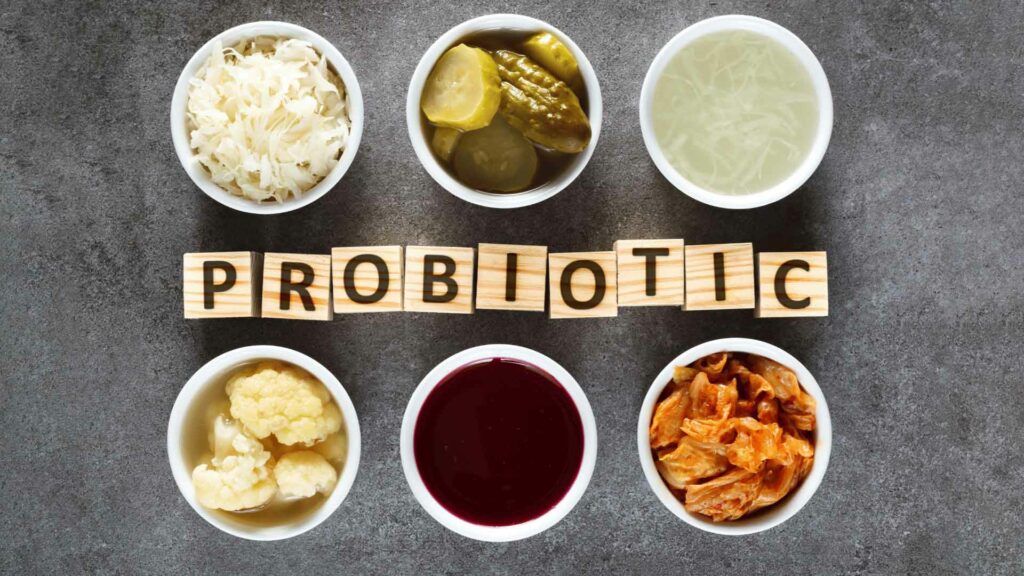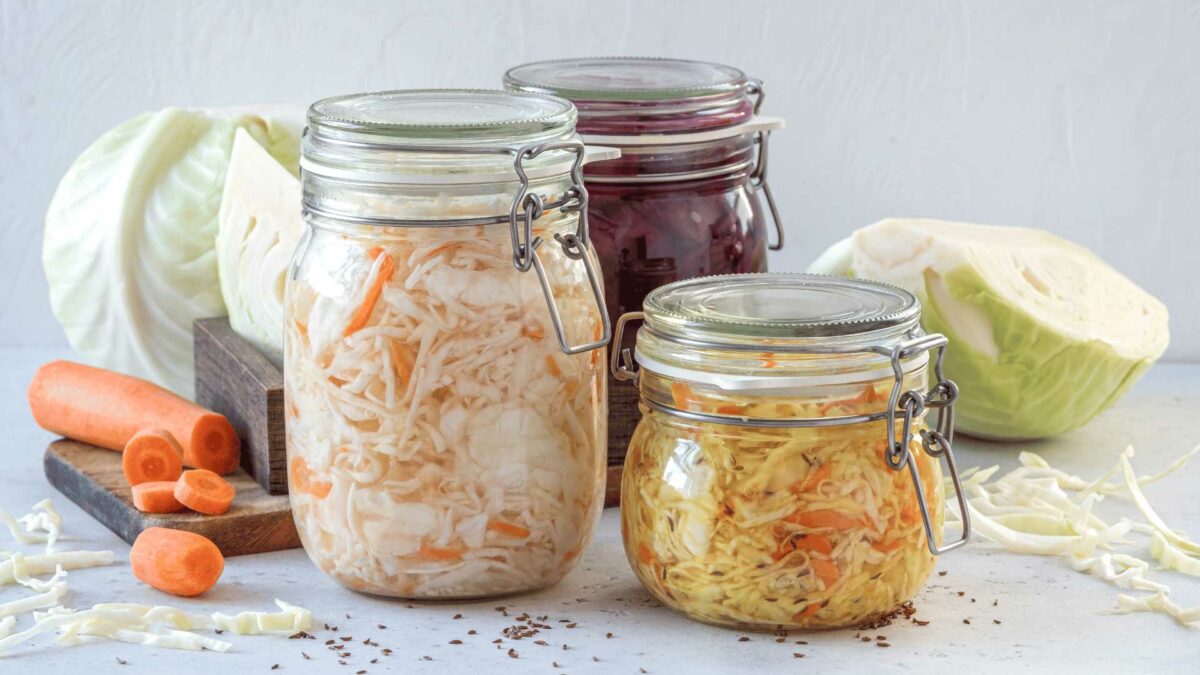During the fermentation process, sauerkraut gets more vitamins, especially vitamin C and helps the body absorb nutrients better. This makes it good for digestion, among many other benefits.
Sauerkraut (German: “sour cabbage”) is fermented, finely cut raw cabbage. Some recipes include onions, carrots, and spices. It has both prebiotics and probiotics, which means it gives the intestine both fiber and good bacteria to help it work.
There are up to 13 different types of probiotics present in sauerkraut (each sauerkraut recipe may contain different ones).
How to Prepare Sauerkraut: 3 Easy Recipes
These are the step-by-step instructions for three simple sauerkraut recipes made with cabbage and salt. Experiment with the one you like the most.
SAUERKRAUT
1 kilogram / 2 pounds approx.
INGREDIENTS:
Option a
- 1 white or purple cabbage
- 3 tablespoons pink salt (or sea salt)
Option b
- 1 white or purple cabbage
- 3 tablespoons pink salt (or sea salt)
- 1 grated apple
Option c
- 1 white or purple cabbage
- 3 tablespoons pink salt (or sea salt)
- ¼ julienned red onion
- ½ grated carrot
- 1 sliced serrano pepper (optional)
Tip: It’s preferable to use organic cabbage. If you can’t get it, just take care to wash it very well.
MATERIALS:
- 1 bowl
- 1 or several glass jars (with or without a lid)
- 1 wooden spoon
- Tea towels, kitchen cloths, or lids
- Rubber bands or ties
Notes:
Use only glass containers and avoid metal utensils as much as possible.
You must make sure that your glass jars are clean and sanitized. Simply add some boiling water and vinegar to sterilize them, then dry them off.
INSTRUCTIONS:
- Take the top leaves off the cabbage and set them aside.
- Cut the cabbage into thin strips (julienne) or any other shape you like (trying to keep the same size).
- Add salt, mix a little with your hands, and let it sit for 15 to 30 minutes.
- Once the cabbage has rested, start massaging it to get all its liquid out.
- If you include the apple, add it at this point in the process and continue massaging.
- Add the rest of the ingredients once you have enough liquid. If you want to add chili, you can either use gloves or a wooden spoon.
- Move it to a glass jar (or several) and pack it down with your hands. The liquid must come up an inch or two above the cabbage.
- Fold the sheets you set aside and press them to the bottom to create a kind of lid. You can also add a stone (or something similar) to add weight.
- Cover the jar with a tea towel or kitchen cloth, or with the lid of the container (unsealed).
- Let it rest for 3 to 5 days in a place where it receives light (not direct sunlight).
- You can eat it after 3 to 5 days (though ideally 1 to 3 weeks), keeping it refrigerated.
Note: If mold grows, take it off as long as it’s only on top and keep the fermentation going (remember that we are feeding bacteria).
Tips:
You can place a plate under the container in case there is an overflow of liquid.
The fermentation depends on the taste of each person and the climate.
- Less time: milder flavor, less acidic
- More time: strong, assertive, acidic flavor
Why Include Fermented Foods in Our Diet?

There are billions of bacteria inside of us, and it’s best for us to keep a good relationship with them. Together, they make up the gut microbiome, a rich ecosystem that performs a variety of functions in our bodies.
The bacteria in our intestines can break down food that our bodies can’t digest, make important nutrients, keep our immune systems in check, and keep us safe from dangerous germs. It is important for a healthy microbiome to have a variety of good bacteria.
We can manipulate the balance of our microbiome by paying attention to what we eat. Dietary fiber from foods such as fruits, vegetables, nuts, legumes, and whole grains is the best fuel for gut bacteria. And the more fiber we eat, the more fiber-digesting bacteria colonize our gut. Less fiber means less fuel for our gut bacteria, essentially starving them to death. In fact, some may even begin to feed on the mucous lining of the intestine.
The way the food is prepared is also important. Fresh, unprocessed foods generally have more fiber and provide better fuel. There are also ways of preparing food that can introduce good bacteria into our gut, also known as “probiotics.”
Fermented foods are packed with probiotic bacteria, and it’s important to know the benefits of fermentation. Fermentation was used to store food before refrigeration was invented, and it is still done in many places around the world today.
Foods like sauerkraut, kimchi, kombucha, etc., add variety and vitality to our diet.
Benefits of Sauerkraut
It is important to note that the benefits of sauerkraut apply to those that have not been pasteurized. By making it at home or buying it from specialized sites, we ensure that we are consuming a product that has all the benefits of cabbage fermentation, which we will see below.
1. Helps the absorption of nutrients
It gets rid of some of the anti-nutrients that block the absorption of good nutrients and also improves the availability of some phytonutrients (“Phyto” means plant, literally, “plant nutrient”).
2. Reduces gas production
Some people get gassy when they eat raw cabbage, but steaming it, including it in a recipe or fermenting it will reduce gas due to the alteration in carbohydrates.
3. Improves digestion
It helps improve our bowel movements, digestive juices and the release of enzymes, making it good for digestion in general.
4. Increases lactic acid
Unfriendly bacteria don’t like acid, so lactic acid won’t do anything to our good bacteria, but it will inhibit the bad ones. Lactic acid is also necessary to help absorb certain minerals.
5. Good source of vitamin C
Certain types of sauerkraut have around 700 milligrams of vitamin C, so it will give us ten times the amount our bodies need for many things: energy, strengthening the arterial wall and improving our immune system.
6. Spikes vitamin K2
Vitamin K2 helps prevent calcium buildup in the wrong places, among other benefits.
7. Rich in fiber
Fiber feeds the good bacteria in our intestines, which then produce compounds that help our immune system, as well as regulate blood sugar and help feed the colon’s own cells (80% of our immune system is found in our gut).
8. Reduces inflammation
It is known that it can help reduce the inflammatory process in the intestine.
Could there be more reasons to consume sauerkraut? It seems not! Let’s all enjoy this ancient tradition that is very beneficial for our health.
DISCLAIMER
This information is not presented by a medical practitioner and is for educational and informational purposes only. The content is not intended to be a substitute for professional medical advice, diagnosis, or treatment. Always seek the advice of your physician or other qualified healthcare provider with any questions you may have regarding a medical condition. Never disregard professional medical advice or delay seeking it because of something you have read.



